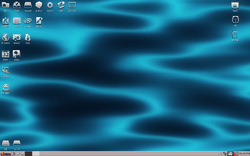List of Linux distributions that run from RAM

Puppy Linux 5.10 desktop running in RAM
This is a list of Linux distributions that can be run entirely from the computer's RAM. That ability allows them to be very fast, since reading and writing data from/to RAM is much faster than on a hard disk drive. Many of these operating systems will load from a removable media such as a Live CD or a Live USB stick. A "frugal" install can also often be completed, allowing boot up from a hard disk drive instead.
This feature is implemented in live-initramfs and allows the user to run a live distro that does not run from ram by default by adding toram to the kernel boot parameters.[1]
Additionally some distributions can be configured to run from RAM, such as Ubuntu using the toram option included in the Casper scripts.[2]
Table
See also
- tmpfs; by mounting a tmpfs and running files that are placed on this, files and programs can be run from RAM, even on Linux distros that do not run completely in RAM
- Clustered file system; network file systems are another way to avoid needing to use a (slow) harddisk (at least faster if using a E-IDE harddisk)
- initrd ("initial ramdisk"), a scheme for loading a temporary root file system into memory in the boot process of the Linux kernel.
- Lightweight Linux distribution
- List of tools to create Live USB systems
- SYSLINUX, a suite of lightweight IBM PC MBR bootloaders for starting up computers with the Linux kernel.
- Windows PE, a non-Linux operating system that can also be run from RAM.
References
- ↑ "Re: Debian live entirely in RAM?".
- ↑ Ubuntu Wiki (13 November 2014). "Booting Ubuntu To RAM". Retrieved 18 July 2011.
- ↑ "Alpine Linux 2 review - LinuxBSDos.com". linuxbsdos.com. Retrieved 7 January 2017.
- ↑ "Alpine Linux:Overview - Alpine Linux". alpinelinux.org. Retrieved 7 January 2017.
- ↑ "The Most Extensive Live-usb on the Planet!". antixlinux.com. antixlinux. Retrieved 30 April 2018.
- ↑ "AUSTRUMI". latgola.lv. Retrieved 7 January 2017.
- ↑ "Boot on Bare Metal with PXE". coreos.com. Retrieved 17 January 2018.
- ↑ "DSL information". damnsmalllinux.org. Retrieved 7 January 2017.
- ↑ [www.grml.org/team/], the Grml team. "grml.org - Debian Live system / CD for sysadmins and texttool-users". grml.org. Retrieved 7 January 2017.
- ↑ kanotix.com. "kanotix.com :: GNU Linux Live system based on Debian, optimized for HD-install and high performance". kanotix.com. Retrieved 7 January 2017.
- ↑ "Knoppix Cheatcodes - USB Pen Drive Linux". pendrivelinux.com. 30 January 2007. Retrieved 7 January 2017.
- ↑ LPS Main Page Archived 2 September 2012 at the Wayback Machine.
- ↑ "Trusted End Node Security". Distrowatch.com. Retrieved 12 February 2018.
- ↑ "Macpup - The beauty of Linux". macpup.org. Retrieved 7 January 2017.
- ↑ "Nanolinux Download". softpedia.com. Retrieved 7 January 2017.
- ↑ "Nanolinux". sourceforge.net. Retrieved 7 January 2017.
- ↑ Parted Magic - About
- ↑ "PCLinuxOS Magazine - HTML". pclosmag.com. Retrieved 7 January 2017.
- ↑ "Cheatcodes - what they are and how to use them - Porteus - Portable Linux". porteus.org. Retrieved 7 January 2017.
- ↑ DistroWatch. "DistroWatch.com: Puppy Linux". distrowatch.com. Retrieved 7 January 2017.
- ↑ "PuppyLinux: MinimumSystemRequirements". Puppy Linux Wiki. Retrieved 13 February 2014.
- ↑ Documentation - Slax Linux
- ↑ "SliTaz". slitaz.org. Retrieved 7 January 2017.
- ↑ "SliTaz installation". slitaz.org. Retrieved 7 January 2017.
- ↑ Contributors, SliTaz. "SliTaz Boot Floppies". slitaz.org. Retrieved 7 January 2017.
- ↑ "SystemRescueCd". sysresccd.org. Retrieved 7 January 2017.
- ↑ "Tails - Privacy for anyone anywhere". boum.org. Retrieved 7 January 2017.
- ↑ "Tin Hat - opensource.dyc.edu". dyc.edu. Archived from the original on 17 October 2016. Retrieved 7 January 2017.
- ↑ Contributors, SliTaz. "Tiny SliTaz - Builder". slitaz.org. Retrieved 7 January 2017.
- 1 2 Shingledecker, Robert. "Frequently Asked Questions". Tiny Core Linux Frequently Asked Questions (FAQ). Retrieved 28 September 2016.
An absolute minimum of RAM is 46mb. TC won't boot with anything less. ... Microcore runs with 28mb of ram.
External links
- Using a liveCD as your Linux Desktop at the Wayback Machine (archived 7 February 2013)
This article is issued from
Wikipedia.
The text is licensed under Creative Commons - Attribution - Sharealike.
Additional terms may apply for the media files.